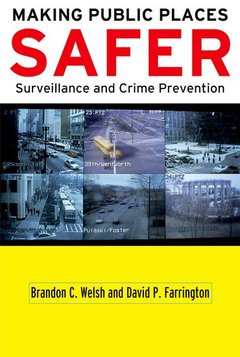Description
Making Public Places Safer
Surveillance and Crime Prevention
Studies in Crime and Public Policy Series
Authors: Welsh Brandon C., Farrington David P.
Language: English
Subjects for Making Public Places Safer:
Approximative price 49.02 €
Subject to availability at the publisher.
Add to cart
Publication date: 11-2009
176 p. · 16.2x24.3 cm · Paperback
176 p. · 16.2x24.3 cm · Paperback
Description
/li>Contents
/li>Biography
/li>
The United Kingdom has more than 4.2 million public closed-circuit television (CCTV) cameras--one for every fourteen citizens. Across the United States, hundreds of video surveillance systems are being installed in town centers, public transportation facilities, and schools at a cost exceeding $100 million annually. And now other Western countries have begun to experiment with CCTV to prevent crime in public places. In light of this expansion and the associated public expenditure, as well as pressing concerns about privacy rights, there is an acute need for an evidence-based approach to inform policy and practice. Drawing on the highest-quality research, criminologists Brandon C. Welsh and David P. Farrington assess the effectiveness and social costs of not only CCTV, but also of other important surveillance methods to prevent crime in public space, such as improved street lighting, security guards, place managers, and defensible space. Importantly, the book goes beyond the question of "Does it work?" and examines the specific conditions and contexts under which these surveillance methods may have an effect on crime as well as the mechanisms that bring about a reduction in crime. At a time when cities need cost-effective methods to fight crime and the public gradually awakens to the burdens of sacrificing their privacy and civil rights for security, Welsh and Farrington provide this timely and reliable guide to the most effective and non-invasive uses of surveillance to make public places safer from crime.
1. Introduction. Part I: Politics, Theory, and Method. 2. The Politics of Surveillance for Crime Prevention. 3. How Might Surveillance Measures Reduce Crime?. 4. Evidence-Based Crime Prevention. Part II: Evidence of Effectiveness. 5. Closed-Circuit Television. 6. Improved Street Lighting. 7. Security Guards, Place Managers, and Defensible Space. Part III: Policy Choices and Challenges. 8. Safer Streets, Safer Cities: Policy Choices for America. 9. Conclusions and Future Directions. Appendix: Methods of Systematic Review and Meta-Analysis. Notes. References. Index.
Brandon C. Welsh is an Associate Professor in the College of Criminal Justice at Northeastern University and Senior Research Fellow at the Netherlands Institute for the Study of Crime and Law Enforcement. He is an author or editor of seven books, including Saving Children from a Life of Crime: Early Risk Factors and Effective Interventions (OUP, 2007), Preventing Crime: What Works for Children, Offenders, Victims, and Places, and Evidence-Based Crime Prevention. David P. Farrington, Ph.D., is Professor of Psychological Criminology in the Institute of Criminology, Cambridge University. He is a former president of the American Society of Criminology, the British Society of Criminology, and the European Association of Psychology and Law.
© 2024 LAVOISIER S.A.S.




